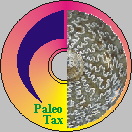Short overview (PaleoTax Application)
General
- PaleoTax is a taxon-based database application for recording data from the literature (indication of taxa at localities of a specified age) or recording of specimens, with the intention to have an information system for the daily work, and to be able to estimate recorded data. PaleoTax is an application library independent from Hdb2Win. There are other application libraries.
- Extremely small and compact database kernel which is able to manage also relatively high amounts of data (e.g. > 50,000 indications, 3 million single information units) without getting slowly
Data recording
- References with authors, journals, optional key words
- Taxa from the phylum to the subspecies level, type species and types
- Localities with countries and regions, sample points, beds, LL-data, a complex, a palaeogeographic unit, age
- Stratigraphical data ("ages") with fixed lower and upper boundary, biozones, lithostratigraphy
- Specimens with collection, locality, preparations, photos of preparations, films
- Citations in references, examined samples, indications of taxa at localities
- Pictures (JPG, BMP, GIF, WMF), references, personal notes and documents (PDF, HTM, DOC, RTF, XLS, ...) may become part of the database
Data output
- Reports on species, genera, localities
- Synonymy lists and reference lists
- Output to HTML or RTF
- Catalogues of species, citations (Fossilium Catalogus), and localities to RTF
- Output of the whole database into HTML
- Plotting of occurrences in a map system (Example).
Data estimation
- Stratigraphial distribution of genera and species
- Abundance of genera and species through the time
- Rate of endemicity of taxa
- Dating of undated faunas
- Results are shown in graphs
- etc. pp.
Miscellaneous
- Consistency check during data recording and for the whole database
- Multiple reorganisation modes to keep data integrity also after system crash or power down
- Backup copies
- Data can be used from two or more databases
- Structure and forms can be extended without problems
- Import of data (from text files, DBF) and export is no problem
|
© Hannes Löser, Hermosillo, Sonora, Mexico.
Updated : 04-30-2023.

